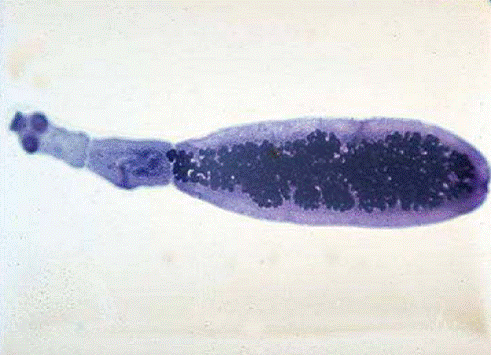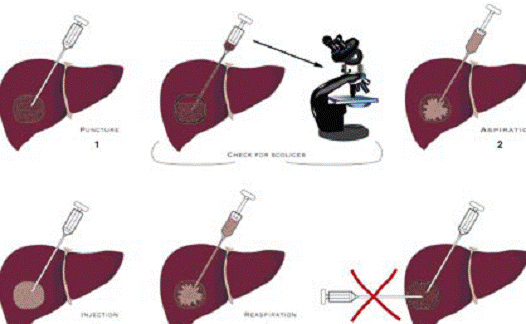Another alternative in the treatment of hepatic cystic echinococcosis (Part two)
Our country is located in one of the main foci of hydatid endemism (Balkan Peninsula). For this reason, greater attention should be exercised in the recognition and treatment of this pathology, which causes serious social and economic consequences.
Echinococcosis (Hydatidosis) is a parasitic zoonosis caused by the mature and larval stage of the cestode Echinococcus granulosus. Reports on this pathology belong to the 4th century BC, described by Hippocrates as cysts filled with water, and since then, certainly, there have been many advances regarding the methods of analysis, control, and possibilities of preventing this disease, surgical treatment techniques as well as less invasive methods. (2)
The parasite, to develop, needs the presence of two mammals, as hosts, to complete its life cycle; a definitive host where the mature tapeworm develops in the small intestine as well as an intermediate host in which the metacestodes develop in organs. The definitive host is usually a carnivore that gets infected by ingesting protoscoleces. These can be thousands inside each cyst and each is capable of developing into a sexually mature form (4 – 7 mm in length). The mature forms produce eggs 20-40 micron and each contains a single embryo (oncosphere), which is eliminated with the feces of the definitive host. The eggs are capable of surviving for a long time in various environments where they fall and are ingested by a large number of herbivorous species that thus are considered as intermediate hosts. 3) In Albania, only the form of Echinococcus Granulosus (Cysticus) that is transmitted from dogs to domestic animals has been observed. Humans are infected through direct or indirect contact with the infected dog.
Echinococcus granulosus is a small tapeworm, 2 – 7 mm in length, consisting of:
- Head with 4 suckers
- Neck that is short and narrow
- Body (strobila) that usually consists of 3 or 4 proglottids that sometimes can reach up to 6.(4)
 |
| Fig. 7. Mature proglottid of Echinococcus granulosus filled with eggs. (4). |
From the mid-80s, a less invasive technique was introduced in Europe for the treatment of hepatic hydatid cysts. This technique is less dangerous and more economical than surgical treatment.
The technique in question is named PAIR (Puncture, Aspiration, Injection, and Reaspiration). The main purpose of this paper is the description and general awareness of these methods, and why not, their possible application in our country, certainly in suitable cases.
PAIR is the most appropriate technique for hepatic cysts CL, CE1, CE2, and CE3, especially those with a diameter larger than 5 cm as well as for multilocular and multiple cysts, always larger than 5 cm. (5).
This technique consists of percutaneous puncture under Ultrasound, aspiration of the cystic content, and injection of a substance with scolicidal action (usually 95% sterile alcohol) in a quantity equal to 1/3 of the aspirated fluid and finally re-aspiration of the cystic content after 5 minutes. When 15% NaCl can be used, it should be re-aspirated after 15 to 20 minutes. (5)
In its early days, the PAIR technique was reserved for patients who could not undergo or who refused surgical intervention. After the initial positive experiences, all cysts of the groups CE1 and CE2 that did not respond positively to medical therapy were treated with the PAIR method. (6)
It is emphasized that this technique should only be applied by expert doctors, under the care of an intensive therapy specialist who must be ready to intervene in case of intraoperative complications.
The PAIR technique should only be applied to patients who have previously undergone chemotherapeutic treatment with Benzimidazoles at least for 4 days before the treatment and at least for 1 month post-PAIR with Albendazole or for 3 months with Mebendazole, to reduce the risk of secondary cyst recurrences.
PAIR is the most suitable technique for the treatment of hepatic cysts CL, CE1, CE2, and CE3, especially when they have a diameter larger than 5 cm as well as for multilocular and multiple cysts, always when they are larger than 5 cm in diameter. (7)
 |
|
Fig . 8 : Schematic presentation of the PAIR procedure.
WHO/CDS/CSR/APH/2001.6 . PAIR: Puncture, Aspiration, Injection, Re-Aspiration An option for the treatment of Cystic Echinococcosis World Health Organization Department of Communicable Disease, - Surveillance and Response. Page 20. |
Legend of Fig. No. 8 :
- Puncture and microscopic evaluation of the cystic content.
- Aspiration of the content.
- Injection of the scolicidal substance
- Reaspiration of the injected substance
- The cyst must be punctured transhepatically and not on the most exteriorized part.
This technique can also be used in patients who have presented a recurrence after a surgical intervention or who have not had an effect from chemotherapy.
Meanwhile, it is contraindicated in the treatment of superficial cysts, those that are calcified or those that have communications with the biliary ducts (due to cholangitis that can be caused by the contact of scolicidal substances with the biliary lines. (8)
Recurrence cases are described as rare (1 – 6 %), while lethal outcomes . (0,1%). (9)
In the world literature, there are many references to the pharmacological treatment of hydatid cysts, with results that are noteworthy.
The authors (9) have followed and documented over 2000 cases of patients treated with benzimidazole preparations and 12 months after the treatment have presented these achieved results :
- 10 – 30% of patients have had a regression of the cysts.
- 50 – 70% have had cyst degeneration or even a reduction in volume.
- 20 – 30% have not presented any change.
Greetings! I would like to have contact with Dr. Viktor Qershniku because my mother has such a disease. She has been operated on twice within a four-year period and it has recurred again. I would like a consultation from your side. Thank you!
Sent by Monika, më 24 October 2017 në 06:04
Dear Monika,
Can you contact me by phone at
Number 0672161158.
With respect,
Viktori
Replay from Dr. Viktor QERESHNIKU, më 24 October 2017 në 13:13
Hello doctor. Many doctors suspect that my mom has this kind of disease, but the examinations conducted at the American Hospital in Tirana show that she has a cyst with fluid in the liver. She has been treated with medications recommended by the American Hospital and herbal remedies for almost 6 months and there has been no result. Please respond to this case because I am very worried about it. Once again, I am pleading
Sent by Eva Mucmata, më 18 February 2019 në 00:38
Honored ....... ,
I recommend that in your possibility of consulting the patient in Tirana, to send me the Echos made in Kukës and in Tirana as well as all the analyses available, as well as to inform me about the concerns of the patient.
Do you have a dog at home?
With respect,
Viktor QERESHNIKU
Replay from Dr. Viktor QERESHNIKU, më 18 February 2019 në 01:59
Dear Eva,
I recommend that if you have the possibility to consult the patient in Tirana, to send me the Echos done in Kukës and in Tirana as well as all the available analyses, and to inform me about the patient's concerns.
Do you keep a dog at home?
With respect,
Viktor QERESHNIKU
Replay from Dr. Viktor QERESHNIKU, më 18 February 2019 në 02:01
Hello doctor, my father has cysts in his liver, one is 9cm and another is 6cm. They have told him to undergo surgery but my father does not want to do it now but rather in October. I would like to know if there is a possibility that the cysts could rupture and what kind of risk comes from the rupture of a cyst?
Please return an answer.
Thank you!
Sent by Majlinda, më 06 May 2019 në 11:37
Honorable Majlinda,
as you have been informed, I believe, you must be aware that echinococcus cysts are in various stages of development, depending on which the treatment also depends. With as much as you have informed, I cannot give a precise answer on how to proceed.
However, it is important to start treatment with ALBENDAZOLE 2 x 400 Mg. Once daily for 28 days, 14 days break, and then repeat another two cycles.
After these cycles, do a good ultrasound and the antigen analysis.
We can communicate further in the future.
Regards
Replay from Dr. Viktor QERESHNIKU, më 08 May 2019 në 09:38
Hello Dr. Viktori. I am Silvana and my mom has a cyst in her liver. The doctor recommended not to treat it for 6 months. Is it normal not to take any medicine during this time? And can it heal without treatment? With respect, Silvana from Lushnja
Sent by Mikela Xhyra, më 07 July 2019 në 13:23
Dear Silvana,
If it has been proven to be a
CYST OF THE CYSTIC ECHINOCOCCUS OF THE LIVER,
of course, it must be treated first
and followed dynamically.
Best regards.
Respect
Replay from Dr. Viktor QERESHNIKU, më 14 July 2019 në 02:29
Honorable Silvana,
If it has been proven to be a
CYST OF THE LIVER HYDATID CYST,
it certainly needs to be treated first
and followed dynamically.
Past events.
Respects
Replay from Dr. Viktor QERESHNIKU, më 14 July 2019 në 02:30
Hello Doctor,
I have a brother with Echinococcosis and it has progressed, recently it has enlarged to 14 by 12 and I wanted to ask you if there is any treatment without surgical intervention. I have also done a scan and it says that it is a Cystic Echinococcus of the Liver.
How can I proceed in this case because I am very confused and honestly, I don't have much faith in surgical interventions
Sent by Maliq Mici, më 04 Agust 2019 në 23:57
Dear Maliq,
When the diagnosis is confirmed,
Treatment must begin with
ALBENDASOL 2X400 Mg daily for
at least 1 to 2 cycles of 21 days and
Then there are 2 alternatives:
1. Open surgery with a scalpel
2. PAIR technique without opening, which
maybe should be inquired at the American Hospital if they perform it.
It should not be left untreated.
Best regards
Replay from Dr. Viktor QERESHNIKU, më 09 Agust 2019 në 03:59
Dear Maliq,
When the diagnosis is confirmed,
Treatment must begin with
ALBENDAZOLE 2X400 Mg per day for
at least 1 to 2 cycles of 21 days and
Then there are 2 alternatives:
1.: Open surgery with scalpel
2.: PAIR technique without incision, which
maybe should be inquired at the American Hospital if they do it.
It should not be left untreated.
Best regards
Replay from Dr. Viktor QERESHNIKU, më 09 Agust 2019 në 03:59
Where can we find you for a visit, please the address, phone, and do we need to make an appointment?
Sent by Nora, më 14 September 2019 në 19:34
With pleasure, we can communicate
to help you as much
as we can.
I am in Tirana and my phone number
is 0682151598.
Regards,
Viktori
Replay from Dr. Viktor QERESHNIKU, më 15 September 2019 në 10:25